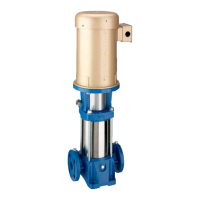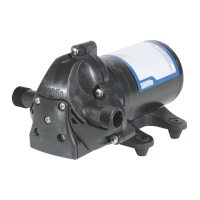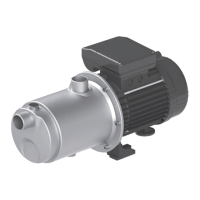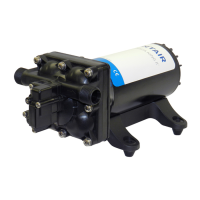6
NOTE
If the unit has a tandem shaft, protector (29) is not used.
16. Outboard bearing (38) is press fitted onto shaft (65). To
remove it, place a puller on bearing cartridge (36) and pull
cartridge, grease seal (37) and bearing from shaft. The
grease seal can be pressed from the bearing cartridge if it
needs replacing, then slide slinger (39), lantern ring (52) and
bushing (56) off shaft (65) single stage, (71) two stage.
Refer to Fig. 11.
17. Removal of inboard bearing is basically the same as for out-
board bearing. Remove capscrews (41) and slide slinger (40),
cartridge cap (42), grease seal (43) and gasket (44) off shaft.
18. Pull or press off bearing cartridge (45), grease seal (46) and
bearing (47). Remove slinger (48), lantern ring (52) and
bushing (56) from shaft.
19. If pump has right-hand rotation, unscrew and remove outboard
sleeve (57) first. Remove O-ring (62) single stage, (58) two
stage. If pump has left-hand rotation, unscrew and remove
inboard sleeve (64) single stage, (65) two stage first. Remove
O-ring (58) single stage, (66) two stage. Refer to Fig. 12.
20. Key (63) holds impeller (59) and either sleeve (64) if pump is
right-hand or sleeve (57) for a left-hand pump. These parts
can be removed by pulling impeller from shaft (65) and
removing key (63) from its position in keyway and sleeve.
Unscrew and remove remaining sleeve and gasket.
21. Disassemble wearing ring(s) (61) (optional) from impeller
(59) only if necessary. On power frames 5, 6B and 7, remove
setscrews (78). Apply a puller and gradually withdraw
wearing rings (61) from impeller (59). Wearing rings may
have to be cut or trimmed off the impeller. If a lathe is used to
trim rings off, use care not to clamp impeller too tight and
cause distortion. Also use care not to remove any metal
from impeller.
22. Remove locking and locating pins (66, 67 and 68) from
casing half (69) only if replacement is necessary.
23. Nameplate and its securing screws should be removed only if
replacement is necessary.
24. For pump Model 413 unscrew capscrews (75) to remove
motor and motor bracket (74) from casing half (69). The
motor can be separated from motor bracket by removing
capscrews (73).
DISASSEMBLY OF A PUMP WITH MECHANICAL SEALS
1. Perform disassembly procedure as previously given through
step 8.
2. Loosen and remove four nuts (18) and washers (19) thus
freeing swing bolts (22) to allow shaft and impeller assembly
to be lifted from casing half (69) with sling and hoist or crane
as described in paragraph 10.
Use extreme care in moving assembly. Mechanical seal,
seats and washers can be cracked by just sliding loose on
shaft. To prevent this, wrap seal securely in a shop cloth
or other protective covering.
3. With shaft and impeller assembly on a suitable bench,
cradle, or work stand, loosen and remove pipe plug (12)
from inboard cartridge cap (42). Remove grease zerk (10)
and capscrews (41) and slide the cartridge cap with grease
seal (43) off end of shaft (71). Remove gasket (44).
4. Pull or press bearing cartridge (45), grease seal (46) and
bearing (47) off shaft. Remove slinger (48).
5. One piece gland (49) used with mechanical seal assembly
can now be removed from shaft. O-ring (50) can be
removed from seal gland if desired.
Exercise great care in removing seal assembly (53) to
keep from marring or otherwise damaging precision
ground mating surfaces.
6. Scribe a mark on shaft sleeves for relocating seal collar on
reassembly. Loosen setscrews (55), securing seal collars
(54) to shaft sleeves and slide them off.
7. Proceed with further disassembly of outboard ball bearing
and seal assembly using same basic procedure.
8. After removal of mechanical seals, proceed with balance
of disassembly in the same manner as described for pack-
ing design.
Figure 11. Outboard rotating element components removed,
illustrating disassembly.
Figure 12. Sleeve and O-ring removed.
CAUTION
CAUTION
MODELS 411-412-413

